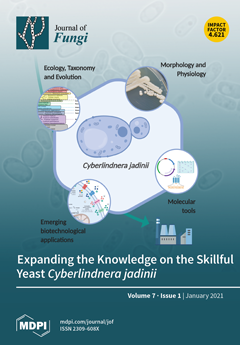Postharvest fruit rot caused by
Fusarium incarnatum is a destructive postharvest disease of muskmelon (
Cucumis melo). Biocontrol by antagonistic microorganisms is considered an alternative to synthetic fungicide application. The aim of this study was to investigate the mechanisms of action involved
[...] Read more.
Postharvest fruit rot caused by
Fusarium incarnatum is a destructive postharvest disease of muskmelon (
Cucumis melo). Biocontrol by antagonistic microorganisms is considered an alternative to synthetic fungicide application. The aim of this study was to investigate the mechanisms of action involved in the biocontrol of postharvest fruit rot in muskmelons by
Trichoderma species. Seven
Trichoderma spp. isolates were selected for in vitro testing against
F. incarnatum in potato dextrose agar (PDA) by dual culture assay. In other relevant works,
Trichoderma asperellum T76-14 showed a significantly higher percentage of inhibition (81%) than other isolates. Through the sealed plate method, volatile organic compounds (VOCs) emitted from
T.
asperellum T76-14 proved effective at inhibiting the fungal growth of
F. incarnatum by 62.5%. Solid-phase microextraction GC/MS analysis revealed several VOCs emitted from
T.
asperellum T76-14, whereas the dominant compound was tentatively identified as phenylethyl alcohol (PEA). We have tested commercial volatile (PEA) against in vitro growth of
F. incarnatum; the result showed PEA at a concentration of 1.5 mg mL
−1 suppressed fungal growth with 56% inhibition. Both VOCs and PEA caused abnormal changes in the fungal mycelia. In vivo testing showed that the lesion size of muskmelons exposed to VOCs from
T.
asperellum T76-14 was significantly smaller than that of the control. Muskmelons exposed to VOCs from
T.
asperellum T76-14 showed no fruit rot after incubation at seven days compared to fruit rot in the control. This study demonstrated the ability of
T.
asperellum T76-14 to produce volatile antifungal compounds, showing that it can be a major mechanism involved in and responsible for the successful inhibition of
F. incarnatum and control of postharvest fruit rot in muskmelons.
Full article






